
Kickboxing is a combat sport focused on kicking and punching. The fight takes place in a boxing ring, normally with boxing gloves, mouth guards, shorts, and bare feet to favor the use of kicks. Kickboxing is practiced for self-defense, general fitness, or for competition. Some styles of kickboxing include: Karate, Muay Thai, Japanese kickboxing, Sanda, and Savate.
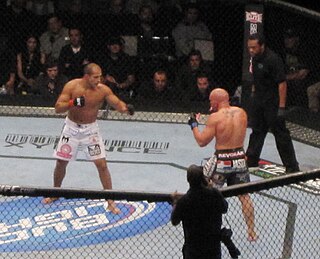
Mixed martial arts (MMA), sometimes referred to as cage fighting, no holds barred (NHB), and ultimate fighting, and originally referred to as Vale Tudo is a full-contact combat sport based on striking, grappling and ground fighting, incorporating techniques from various combat sports from around the world. The first documented use of the term mixed martial arts was in a review of UFC 1 by television critic Howard Rosenberg in 1993. The question of who actually coined the term is subject to debate.

PRIDE Fighting Championships was a Japanese mixed martial arts promotion company. Its inaugural event was held at the Tokyo Dome on October 11, 1997. Pride held more than sixty mixed martial arts events, broadcast to about 40 countries worldwide. PRIDE was owned by the holding company Dream Stage Entertainment (DSE).
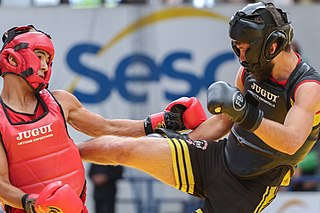
Sanda, formerly Sanshou, also known as Chinese boxing or Chinese kickboxing, is the official Chinese kickboxing full-contact combat sport. Sanda is a fighting system which was originally developed by the Chinese military based upon the study and practices of traditional kung fu and modern combat fighting techniques; it combines boxing and full-contact kickboxing, which includes close range and rapid successive punches and kicks, with wrestling, takedowns, throws, sweeps, kick catches, and in some competitions, even elbow and knee strikes.
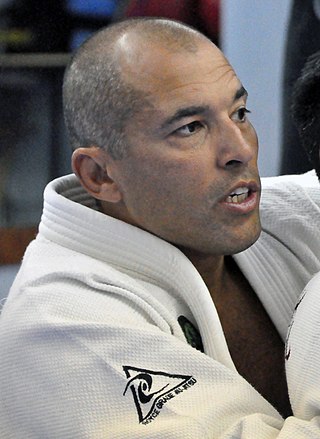
Royce Gracie is a Brazilian retired professional mixed martial artist, a UFC Hall of Famer, and a Gracie Jiu-Jitsu practitioner. A member of the Gracie family, he is considered to be one of the most influential figures in the history of mixed martial arts (MMA). He also competed at PRIDE Fighting Championships, K-1's MMA events and at Bellator.

Lethwei or Burmese boxing, is a full contact combat sport from Myanmar that uses stand-up striking including headbutts. Lethwei is considered to be one of the most brutal martial arts in the world, as the sport is practiced bareknuckle with only tape and gauze while fighters are allowed to strike with their fists, elbows, knees, and feet, and the use of headbutts is also permitted. Disallowed in most combat sports, headbutts are important weapons in a Lethwei fighter's arsenal, giving Lethwei its name of The Art of 9 Limbs, and deemed one of the bloodiest martial arts. A vast majority of Lethwei fighters originate from the Karen ethnicity.

Kazushi Sakuraba is a Japanese professional wrestler, mixed martial artist and submission wrestler, currently signed to Rizin Fighting Federation and Pro Wrestling Noah, where he was formerly one-half of the former GHC Tag Team Champions with Takashi Sugiura. He has also competed in traditional puroresu for New Japan Pro-Wrestling (NJPW) and shoot-style competition for UWFi and Kingdom Pro Wrestling (KPW). He has fought in MMA competition in the Ultimate Fighting Championship, Pride Fighting Championships, Hero's and Dream. He is known as the Gracie Hunter or the Gracie Killer due to his wins over four members of the famed Gracie family: Royler Gracie, Renzo Gracie, Ryan Gracie, and Royce Gracie. Sakuraba is famous for beating 13 champions of different top MMA organizations; opponents who were often many weight-classes above him.

Frank Shamrock is an American former professional mixed martial artist. Shamrock was the first to hold the UFC Middleweight Championship and retired a four-time defending undefeated champion. Shamrock was the No. 1 ranked pound for pound UFC fighter in the world during his reign as the UFC Middleweight Champion. Shamrock has won numerous titles in other martial arts organizations, including the interim King of Pancrase title, the WEC Light Heavyweight Championship and the Strikeforce Middleweight Championship. Shamrock is regarded as one of the first complete mixed martial artists, having adapted his game from a ground-focused style of fighting to a more well-rounded and versatile style.
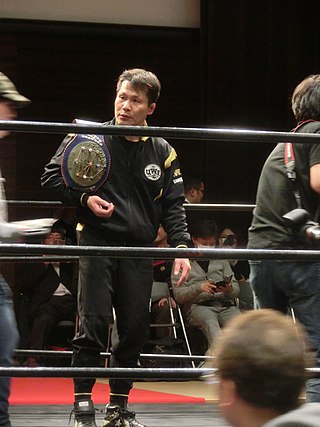
Kiyoshi Tamura is a Japanese retired professional wrestler and mixed martial artist. Once a student of legendary professional wrestlers Billy Robinson, Lou Thesz and Akira Maeda, Tamura was known for his skills in catch wrestling and is considered to be one of the greatest shoot wrestlers of all time. Competing exclusively in shoot style wrestling, Tamura began his career with UWF Newborn and later joined its successor group UWF International before transitioning to mixed martial arts.
Tsuyoshi Kosaka is a retired Japanese mixed martial artist, submission grappler and professional wrestler who competed in the Heavyweight division. A professional MMA competitor from 1994 till 2022, he has competed for the UFC, PRIDE Fighting Championships, RIZIN, RINGS, Pancrase, and DEEP. Kosaka is the former King of Pancrase Super Heavyweight Champion.
Most rule sets for mixed martial arts (MMA) competitions have evolved since the early days of Vale Tudo. As a result of health, legal, and moral concerns, many different rulesets were created, which give different countries and promotions very different tactics and strategies. Similarly, shoot wrestling organizations, such as Shooto, expanded their rulesets to integrate elements of Vale Tudo into their sport. However, for the most part, fighters accustomed to one rule set can easily acclimate to the others.
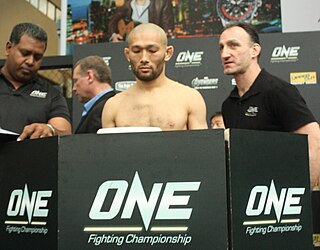
Masakazu Imanari is a Japanese former professional wrestler and current mixed martial artist currently competing in the Bantamweight division of Rizin Fighting Federation. A professional competitor since 2000, he is a veteran of ONE Championship, DEEP, ZST, Pancrase, PRIDE Fighting Championships, and Cage Rage. Imanari also has had a successful career in Combat Wrestling, placing as high as third and second in their All-Japan championship tournaments. He was in the final Cage Rage Featherweight Champion, DEEP Bantamweight Champion, two-time DEEP Featherweight Champion and DREAM Japan Grand Prix Finalist.
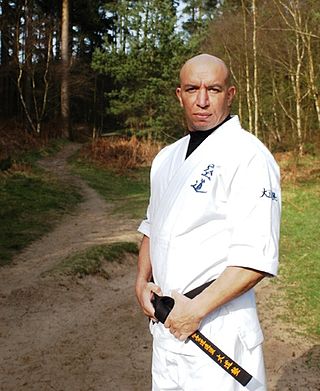
Lee Hasdell is a British martial artist, promoter and former professional kickboxer and mixed martial artist. Hasdell is considered by many to be a pioneer of mixed martial arts in the United Kingdom, particularly in the 1990s, when he drove a great deal of innovation in the field. Hasdell promoted the first professional mixed martial arts events in the UK and helped develop many of the standards within the British MMA scene of today.
Hideo Tokoro is a Japanese mixed martial artist who last competed in the Bantamweight division. A professional competitor since 2000, Tokoro has also formerly competed for Vale Tudo Japan, ZST, Shooto, Rings and K-1 Hero's. He is notable for holding the record for most weight divisions competed in by a professional MMA fighter, at seven, ranging from flyweight through to heavyweight.
Keisuke Fujiwara is a Japanese mixed martial artist with a background in kickboxing.

Jewels 13th Ring and Jewels 14th Ring are two mixed martial arts (MMA) events combined in a single date and location held by promotion Jewels. The events took place on May 14, 2011 at Shin-Kiba 1st Ring in Koto, Tokyo, Japan.

ONE Championship is a Singaporean combat sports promotion. Founded on 14 July 2011 by entrepreneur Chatri Sityodtong and former ESPN Star Sports senior executive Victor Cui, its events have featured mixed martial arts (MMA), submission grappling, kickboxing, Muay Thai and Lethwei bouts.
Final Fight Championship (FFC) is an international fighting sports promotion company founded in 2003 by the FFC owner and CEO Orsat Zovko. The company has its headquarters in Las Vegas, Nevada, USA, as well as a European office in Zagreb, Croatia.

While mixed martial arts is primarily a male dominated sport, it does have female athletes. For instance, Female competition in Japan includes promotions such as DEEP Jewels. Now defunct promotions that featured female fighters were Valkyrie, and Smackgirl. Professional mixed martial arts organizations in the United States that invite women to compete are industry leader Ultimate Fighting Championship, the all female Invicta Fighting Championships, Resurrection Fighting Alliance, Bellator Fighting Championships, and Legacy Fighting Championship. Now defunct promotions that featured female fighters were Strikeforce and EliteXC. There has been a growing awareness of women in mixed martial arts due to popular female fighters and personalities such as Amanda Nunes, Megumi Fujii, Gina Carano, Cristiane "Cyborg" Santos, Ronda Rousey, Miesha Tate, Holly Holm and Joanna Jędrzejczyk and among others. Carano became known as "the face of women's MMA" after appearing in a number of EliteXC events. This was furthered by her appearances on MGM Television's 2008 revival of their game show American Gladiators.
Rizin Fighting Federation is a Japanese mixed martial arts organization created in 2015 by the former Pride Fighting Championships and Dream Stage Entertainment president Nobuyuki Sakakibara.














